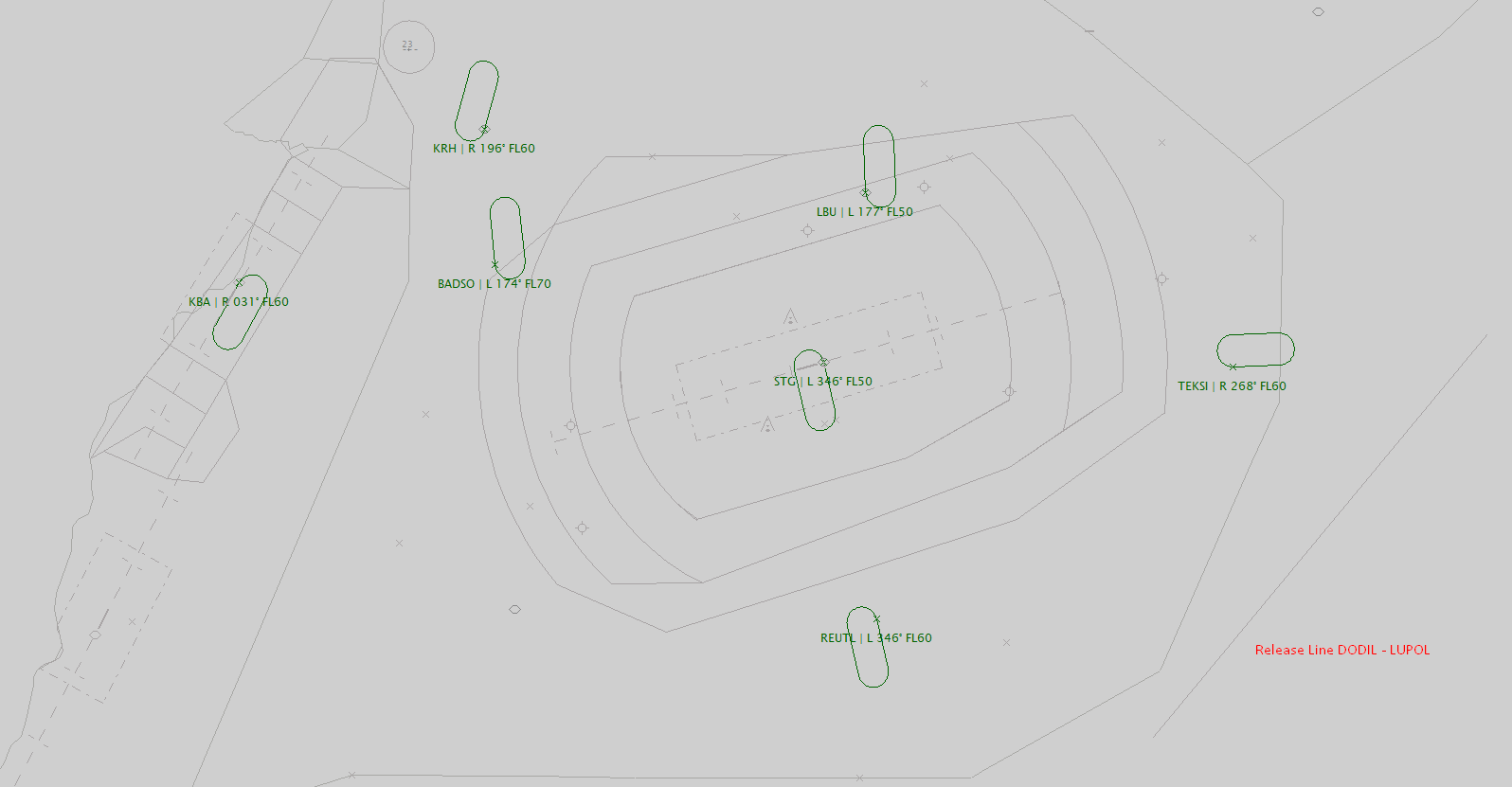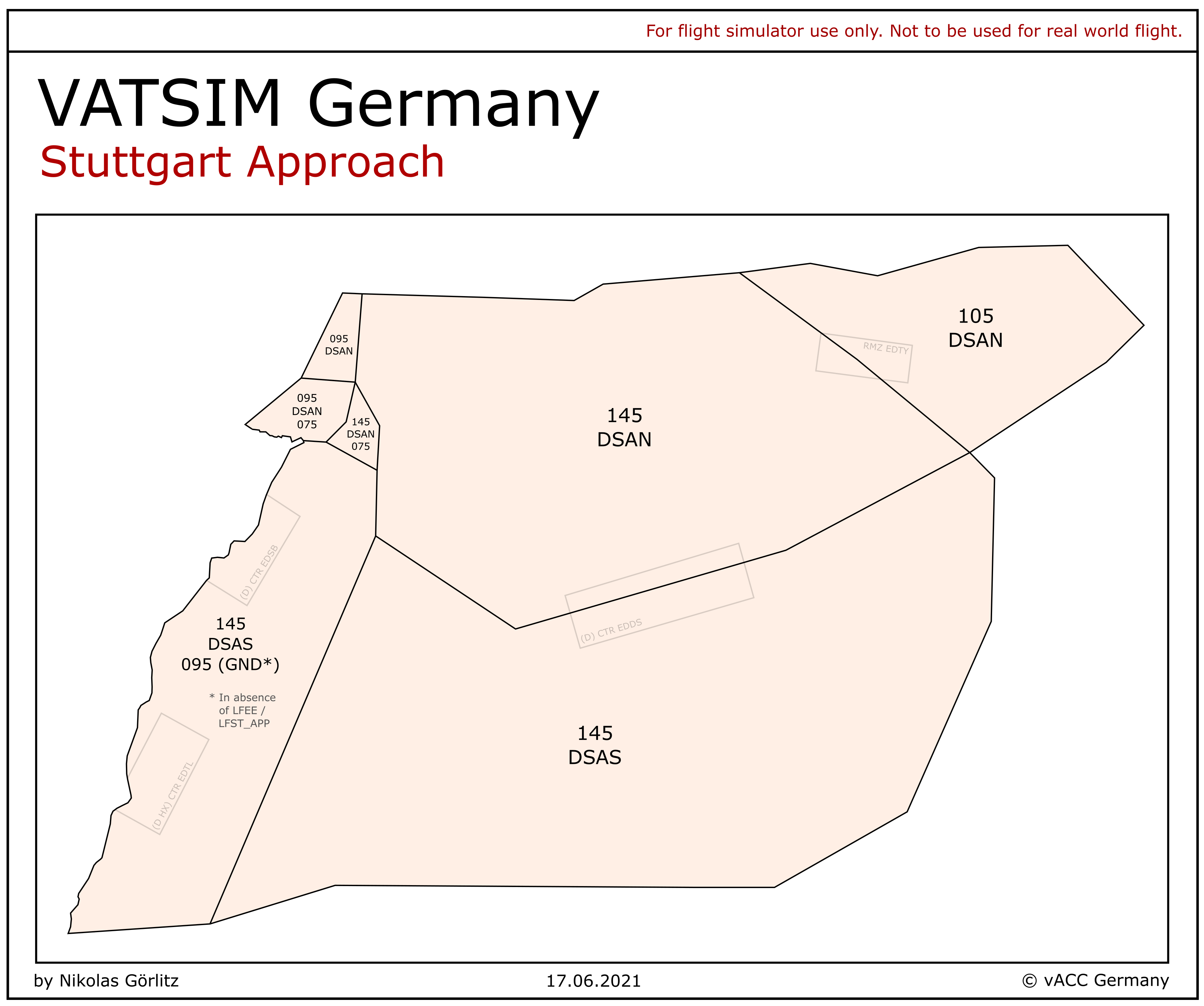SOP EDDS - Arrival
Stuttgart Arrival covers not only Stuttgart (EDDS) but also Karlsruhe/Baden-Baden (EDSB) and Lahr (EDTL) when Strasbourg Approach (LFST_APP) is offline, as well as the uncontrolled airfield Schwäbisch Hall (EDTY), which has instrument procedures.
Sector Splits
Arrival
Sector Stuttgart (STG) is the northern arrival and the primary station. It is responsible for the northern half of the sector. This means, it covers EDTY as well.
Sector Reutlingen (REU) is the southern sector and responsible for the southern half. This means it covers EDSB and EDTL as well when LFST_APP is offline.
Before REU can be staffed, Stuttgart Director (DSAT) has to be online.
Director
Stuttgart Director does not have a separate sector. The handover from the respective Arrival to Director should take place at the latest on downwind. The handover altitudes between Arrival and Director must be coordinated, e.g. 5000ft in the South and FL60/FL70 (depending on the transition level) in the North.
During a constant arrival stream on both downwinds, Arrival should hand over traffic with 16 NM or greater spacing per downwind to enable Director to create an efficient final.
Departure
Stuttgart does not have a Departure position. If both approach sectors are staffed, REU gets all departures to the South (ROTWE, SUL, KUNOD, and ABTAL), while STG gets all departures to the North (KRH, VESID, TAGIK, ETASA, OKIBA, GEBNO, and DKB).
Traffic departing via TEDGO and STG is handed off directly to Director by Tower.
Airspace
Around Stuttgart there is primarily airspace D, which makes it easier to handle VFR transits. However, there is also a larger area above the control zone of Stuttgart with airspace C between 3500 ft and 5500 ft AMSL.
A detailed representation of the airspace structure is available at openflightmaps.org.
Arrival Procedures
Releases by Center
On handoff from Center to Arrival aircraft are released for turns but not for climb/descend as long as they are inside center's sector. Flights via TEKSI and REUTL are released for turns passing DODIL – LUPOL line.
STAR assignment
Stuttgart Arrival needs to clear the desired STAR/Transition if no other arrangements have been made with Center. The following table shows all available transitions. 07/25 transitions put the aircraft onto a downwind for the respective runway, while #E/#W transitions send the aircraft directly to a base leg.
| Waypoints | 07 operations |
25 operations |
|---|---|---|
| ARSUT | - | 25 |
| BABEG |
1E | - |
| BADSO | 07 | 25 |
| DENEL |
1E |
- |
| DITBA | 1E |
- |
| GEBNO | - |
1W |
| IBIRU | 07 |
25 |
| KRH |
07 or 1E |
1W |
| LBU |
07 |
25 |
| LUPOL | - |
1W |
| NOSBU |
07 or 1E |
- |
| REUTL |
07 |
25 or 1W |
| SUL | - |
1W |
| TAGIK |
- |
1W |
| TEKSI |
07 |
25 or 1W |
Out of BADSO, TEKSI, and REUTL, there are STARs that lead directly to an Initial Approach Fix (LBU or STG).
Approach Procedures
During approaches to runway 07, aircraft up to 5.7t MTOM may use all published approaches. For all other aircraft, the ILS approach is mandatory and exceptions are only possible in rare cases (e.g. after a runway change). TheHowever, the RNP approach may also be used by heavier aircraft if the visibility is at least 4000m and the ceiling at least 1000ft AGL. For all other aircraft, the ILS approach is mandatory and exceptions are only possible in rare cases (e.g. after a runway change).
During approaches to runway 25, all aircraft may use all published approaches.
Arrival - or Director if staffed - has to inform Stuttgart Tower about every aircraft not flying an ILS approach.
Target spacing
Stuttgart has only one runway. In order for the towerTower to have sufficient space for departures, inbounds shall be no less than 6 NM (rather 7 NM) apart when touching down and no less than 12 NM (rather 13 NM) during LVP. If there are only few outbounds, less spacing is also possible after coordination with Tower.
For VFR flights within the CTR, the spacing of approaches should be adjusted after coordination with the towerTower (depending on the intention of the VFR traffic, up to more than 10 NM).
Short approaches
Approaches that intercept the localizer after VATER or UNSER have to be approved by Stuttgart Tower.Tower.
Visual approaches
Non-jet aircraft up to 5.7t MTOM may be cleared for a visual approach after coordination with Tower.
| 07 inbounds from the North |
traffic shall fly via reporting point Whiskey and the adjacent forest area and avoid built-up area |
| 07 inbounds from the South |
traffic shall avoid built-up area |
| 25 inbounds from the North |
visual approach not possible |
| 25 inbounds from the South |
traffic shall follow highway A8 and avoid built up area |
Departure Procedures
As far as possible, a continuous climb should be made possible and the transfer to Center should take place early and without conflict. On handoff all departures are full released for further climb and turns.
| Origin | COP | Level | Special Conditions | TO |
|---|---|---|---|---|
|
EDDS EDTY |
ABTAL, KUNOD | 140 | full release | EDMM ZUG / RDG |
| SUL | 140 | LSAS | ||
| DKB, GEBNO | 100 | DKB | ||
| OKIBA | 140 | DKB | ||
| all other | 140 | BAD | ||
| KRH | 80 | max. RFL, rel. for turns | PFA |
| Destination | COP | Level | Special Conditions | TO |
|---|---|---|---|---|
| EDDR | BADLI | 100 | full release | PFA |
|
LFSB LFGA |
LIPKA | 140 | full release | LFSB |
| EDSB | coordination |
coordination | if LFST_APP online | LFST_APP |
Jet aircraft may only be turned off the SID at or above 5000ft (at or above 3000ft for piston and turboprop aircraft) and exceptions are only possible if absolutely necessary (e.g. weather avoidance). Additionally, Stuttgart Tower has to be informed immediately of any traffic being turned off the SID below 5000ft.
Tower SOP
Please also check the EDDS Tower, Ground, and Delivery SOPSOPs to familiarize yourself with Tower procedures relevant for Arrival operations to enable the necessary coordination with Tower.
MVA
Due to high terrain around Stuttgart, special care must be taken here. The MVA for the entire sector can be found in the Topsky maps for Euroscope. For the area around Stuttgart, a MVA map is also available at Chartfox. Due to the MVAMVA, it is not possible to, e.g., let approaches via TEKSI descend directly to 4000ft.4000ft; Instead,instead, at least one intermediate altitude must be used.
For users of a chart service such as Navigraph, an MVA chart is available for EDSB and EDTL underis available through the airportcharts for LFST.
VFR Transits
VFR flights above 5500ft AMSL will fly through airspace D around Stuttgart. Between 3500ft and 5500ft AMSL the controller need to take care of theairspace C airspace!! Flights through C airspace are not recommended but possible with the CVFR clearance.
Holdings
The following holdings are published around Stuttgart:
- BADSO (MHA 5000)
- TEKSI (MHA 5000)
- REUTL (MHA 6000)
- LBU (MHA 6000)
- STG (MHA 7000)

Holdingsholdings within Stuttgart Arrival
Possible Conflicts
- For descending flights, the existing MVA must always be considered, especially below 5000 ft AMSL and west of the airport!
- The potential for conflict between intersecting approaches and departures must be taken into account.
- Even in the case of different departure routes, attention must be paid to the necessary separation of departures due to the fact that they follow the same track in some places.
- Due to the Black Forest (elevated terrain) between EDSB/EDTL and EDDS, the MVA in this area is 6300 ft AMSL, so IFR flights must be at least at FL70 there.

